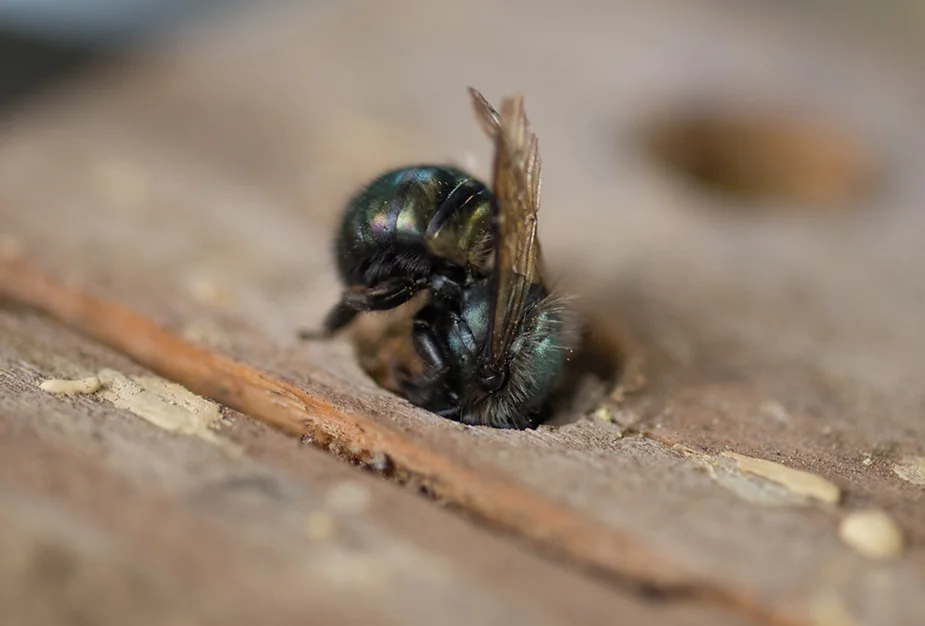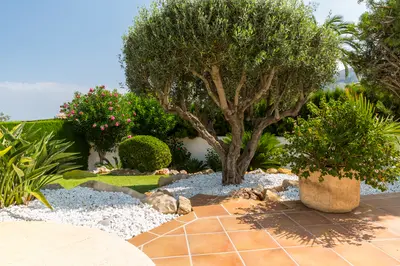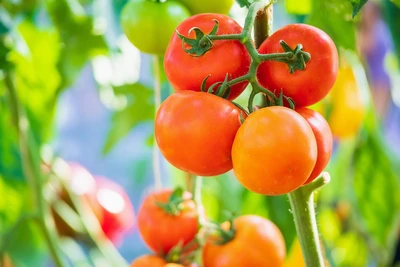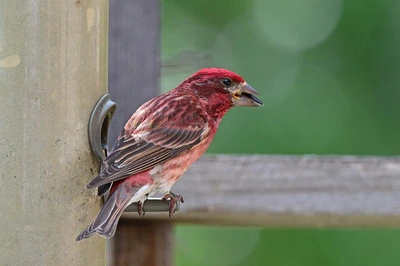
Mason Bees Training 101
For those nervous about inviting bees into your garden, mason bees are the ones for you. Mason bees are solitary, have no hive to defend, are very gentle and rarely sting!
Mason bees do not produce honey but spend all their time pollinating the food we grow to eat. It’s not all about honey! These bees are amazing!
Mason bees are a highly efficient pollinator for many crops across the country. The management of mason bees can be very simple and rewarding for the home gardener and agricultural specialist.
To attract mason bees to your garden, be sure to plant a variety of plants, with different flowering times to ensure blossoms are available for mason bees through the whole season.
Check your local Buckerfield’s Garden Center for our full line of mason bee products. We can answer any questions you have!
What makes mason bees such good pollinators?
Mason bees are very productive pollen gatherers. They carry pollen on the underside of their abdomen and then scrape the pollen off within their nesting hole.
Because the pollen is carried dry on their hair, it is more easily transferred, resulting in significantly more pollinated flowers.
- It is estimated that over 97% of the flowers visited by a mason bee are pollinated.
- Roughly one foraging female mason bee is equivalent to one hundred foraging honey bees. Mason bees only travel 100-200 yards where honey bees can travel up to several miles for forage.
- The Mason bee’s ability to forage under cool and cloudy weather consistently provides adequate pollination for many types of flowers, shrubs, and trees.
- They are fantastic pollinators of spring fruit and nut trees.
The following is a guide for care and release of mason bees.
What do Blue Orchard Mason Bee look like?
- Blue Orchard Mason Bees are smaller than a honeybee, are a shiny metallic dark blue, and have two sets of wings.
- The females are larger than males and have hairs on the underside of the abdomen for carrying pollen.
- Males have a longer antennae and a tuft of light colored hair on the face.
How many bees do I need?
- A single, fully colonized 50 hole nest will pollinate a home owners yard of bushes, flowers and trees.
- A few dozen fruit trees can be adequately pollinated with as little as 50 bees. Simply provide a nest for mason bees and they will reproduce and pollinate your garden, flowers, fruit and nut trees.
Where do Mason bees live?
Their natural habitat is hollow cavities found in tree bark, holes made by tree-eating grubs, woodpecker holes, beetle holes or any naturally occurring hole of the right size.
You can attract mason bees with a mason bee house available at Buckerfield’s.
What is pollination?
Pollination is the transfer of pollen from one flower to another. Fruit becomes larger when more pollen is delivered to the flower. The more pollen the better! The more bees the more pollen! A win win situation!
· It takes about 75 flower visits to gather a full load of pollen, and an average of 25 loads for a pollen wad. The female bee completes about one cell a day, so that means she might visit 1875 blossom a day.
· Mason Bees are very efficient pollinators.
Efficient pollinators
Blue Orchard Mason Bees work directly upon the reproductive structures of the blossoms, collecting nectar and pollen simultaneously.
The female Mason bee takes nectar with her tongue while vigorously shaking the anthers with her bottom, rear and middle legs to collect the pollen.
The male Mason bees also visit flowers but only to get nectar for their own consumption.
Reproducing Mason Bees
Adult mason bees overwinter inside their cocoons until early spring, emerge, mate, females produce offspring and then die. Male mason bees mate and the die.
The egg hatches in about a week. There are 5 larval stages and it is the second stage that starts using the pollen wad for food. The developing larva will cocoon in the 5th stage and pupate in late summer. It then takes about a month to metamorphose to an adult bee, which will then go dormant until the following spring.
Care must be taken during the larval stages that the bee house is secured and not dropped, causing damage to the developing bees. Do not move the nest before fall.
- Males emerge first and wait for the females to leave the nest to mate. The male dies after mating and the female will search for a suitable nesting site. Once a new site is found, she begins gathering pollen and nectar for the next generation of Mason bees.
- The female mason bee goes into the nesting cell in the bee house head first to regurgitate the nectar then backs out, turns around and backs in to deposit the pollen. In her chosen nesting tunnel she mixes the pollen with the nectar to form a pollen lump. Then she lays an egg and attaches it on top of the pollen lump and constructs a mud wall to seal the nest chamber.
- She then starts collecting pollen and nectar again for the next egg. She continues this procedure until she has laid all of her eggs or she dies. A mason bee can lay 30 to 35 eggs.
- A mason bee lays the females at the back of the hole and the males towards the front of the nest. In the event of predator attack the males are sacrificed first, hopefully leaving the females to reproduce next year.
- Female bees need mud close by for sealing the brood chambers as they build their nests. These mud partitions are used to keep predators and parasites out and prevent the larva and pollen from drying. Mason bees will spend more time pollinating blossoms if they don’t have to travel long distances looking for mud.
 Where should I place my bee house?
Where should I place my bee house?
You can attract wild mason bees in your neighborhood by providing a mason bee house or purchase bees to get your colony started. Mason bees emerge and pollinate blossoms all spring. When nest location, weather and food are optimal, mason bees can increase to six times the original population.
- Mason bees like a warm, dry place protected from the wind, rain and direct sun, for their nests. A nest can be fastened to the outside wall of any building, under the eve of a house, barn, shed or some solid structure. Facing east to southeast is ideal – eye level or higher.
- Bees will start foraging earlier in the day if the nest faces east getting the morning sun. Bees need the sun to warm them before they are able to fly!
- Place the bee house as close as possible to flowering trees and other flowers in the area that need pollinating. The closer the nest is to the flowers, the more time can be spent foraging for food and providing for their young.
- Leave the nest in place even after the bees have hatched and they've completed their flight one month later. You don't want to change the surroundings of the nesting area. Once returning females are separated from their food supply, larvae starve and die.
- For the best view of your bees flying to and from the nest, place nest at eye level and watch as the bees seal tunnels with mud to keep their young safe until the following spring.
- Mason bee houses come fully assembled with everything you need to house your mason bees. Check your local Buckerfield’s Garden Center for our full line of mason bee products. We can answer any questions you have!
Getting started with mason bees
Attracting mason bees to your bee nest is like attracting wild birds to your yard. Mason bees require a nest, food, mud source and a good location to be successful in your garden.
The most important step is to have the nest ready for spring. Mason bees search for nesting sites in early spring. For coastal British Columbia set nest out in February before the flowering shrubs begin to bloom. Mason bees are active in early spring and are adapted to cooler weather conditions.
Protect nest from predators
- Protect from squirrels by placing nest inside a sturdy box with one hole allowing the bees to enter and exit.
- Ants are a problem as they eat the pollen and nectar. Put out ant baits, traps or apply tangle foot around the nest to deter ants.
- Woodpeckers feed on mason bees inside the nest but do not eat the larvae or flying bees. Make a wire cage using chicken wire and place 2-3” around the nest.
- Protect from parasitic wasp and other flying insects, by covering nest with finely woven netting.
Food for mason bees
- Nectar and pollen are the essential requirements for mason bees to feed themselves and provide food for their young.
- If there are not enough flowers to provide food, your bees will search elsewhere.
- If flowers are abundant and readily available, the bees will produce more offspring the following year.
No Need to Fear Mason Bees
- Male mason bees don’t have stingers, and since they have no queen to protect and all of the females are fertile, they’re not aggressive.
- Female Mason bees rarely bite or sting, but it is still possible to get stung, though the sting is more like a mosquito bite than your average bee sting.
- Mason bees are fantastic pollinators.
- Mason bees are little black bees that are fun and entertaining to watch. Enjoy a close-up view of these efficient pollinators as they go about their busy day.
How do I purchase Mason Bees?
Mason bees and all the supplies you need to raise bees are available at your local Buckerfield’s Garden Centers. Our knowledgeable staff can help answer any questions and recommend the perfect amount of bees and the best bee house available.
When you purchase mason bees cocoons make sure they are inspected, clean and from a similar climate to your own.
How to care for Mason Bees
After you receive your mason bee package, immediately place the container of cocoons in your refrigerator. Keep the cocoons dry to prevent any mold from growing.
- The bees should be released between March and early May as soon as blooms appear.
- When you are ready to release the mason bees, remove the cocoons from the fridge and place in a dark area out of direct sunlight and allow the bees to warm up to room temperatures. Once they begin to emerge, place the cocoons outside next to your nesting material and protect from predators.
Mason Bee House
Mason Bee Houses are the perfect addition to any yard where trees, flowers, fruits and herbs need to be pollinated. These houses mimic the environment that Mason Bees are naturally attracted to in the wild.
- Mason bees need a small dry nesting space with only one entrance, and prefer a hole size of 5/16” and 5-6” deep. If more than one opening mason bees will avoid nest.
- The front of the tunnel is allotted for males and the back is for females. Shorter or narrower tunnels result in more males which will lower the amount of offspring.
Perfect nesting materials
Shelters can be made of wood, plastic or ceramic and placed in sunny locations.
Wood should be clean and free of slivers, preservatives and any pesticides. Avoid wood like cedar or new green wood. The nesting channels can be made into two adjoining pieces of wood.
Solid blocks of wood can have holes drilled into them. Cardboard nesting tubes should be inserted into drilled holes and replaced each year.
Cardboard nesting tubes are attractive to mason bees looking for suitable nesting material. Tubes are for a one time use and are made out of 100 % recyclable paper. Secure tightly before placing into a shelter.
Plastic trays do not warp and can be stacked together and set into a wooden shelter. These are easily cleaned and can be reused the next year.
Trays made out of corn are the most attractive to mason bees and are set inside a wooden shelter. Trays are quick and easy to clean and are reusable.
Reeds from marshes with hollow stems are a natural source and make a popular nest. Secure tightly together before placing into a shelter.
How many nesting tunnels do I need?
Cocoons need to harvested and counted in the fall to give an estimated amount of nests needed in the spring.
- About 45 nesting tunnels are needed for 100 cocoons.
- A female mason bee lays about 30-35 eggs and will need 5 nesting tunnels.
Observing your bees
Mason bees are fascinating to watch! Use a flashlight at night or in the early morning, you can see the bees at rest in the front of their holes, with their eyes looking out at you. Just watch them at work!
- If a mason bee accidentally goes into another bee’s hole the intruder will quickly back out and find the correct nest. Their individual pheromones help them identify their own hole.
- Watch mason bees as they work on blossoms in your yard, and notice which plants are the favorite. Plant more next year!
Harvesting cocoons
It is recommended you clean both cocoons and nests each fall after you have harvested the cocoons.
- Open nesting trays and remove cocoons from tray by sliding a tool with a curve in the top, under each cocoon and gently lifting them out of the nesting channel.
- Unravel cardboard tubes and place cocoons into a container.
- It is not possible to harvest cocoons from drilled holes in solid blocks of wood, unless they have been lined with cardboard tubes. Cocoons are too fragile and would be destroyed if removed.
Cleaning nests
Proper hygiene means a clean nest, and plentiful healthy bees. Nests contain dried mud, dead bees, parasites and mites and must be cleaned each fall after harvest when empty.
- Soak nesting trays in water and remove mud and debris.
- To kill bacteria and fungi soak trays in a solution consisting of 15 ml of bleach and 4 L of warm water. Rinse well.
Cleaning cocoons
Washing cocoons can prevent the spread of disease and keep your mason bees healthy, disease and parasite free.
Mites will attach themselves to the bees as they emerge in the spring if left on the cocoons. Excessive mites can weigh down the bee and prevent them from flying. Pollen feeding mites will compete with the mason bee larvae for food.
The best time to clean cocoons is in the fall when they are harvested.
- Inspect the cocoons and remove any that are diseased or have parasites.
- Place cocoons into a bucket filled with tepid water. Never use soap or detergent. Cocoons are buoyant and repel water.
- To loosen mud, debris and mites gently agitate the cocoons in the water. Repeat until water is clear and free of mites and mud.
- Mix 15 ml bleach with 4 L of warm water and gently wash cocoons in the solution. Rinse well with clean warm water. This will kill any bacteria or molds.
- Gently wrap cocoons in paper towels and leave to dry. Remove paper towel and check for mites. If mites are still present, further screening must be done.
- Place cocoons on a fine wire mesh frame or a metal sieve and shake gently to dislodge mites. Mites that fall through should be destroyed. Place cocoons on paper towels to dry completely.
How to determine if cocoons have parasites
- Adult mason bee cocoons are dark grey and firm to the touch.
- Cocoons that are lighter in color, appear empty, less firm and drier are parasitized by wasps.
- Throw out questionable cocoons.
- If infested cocoons escape detection, adult wasps emerge in May or June and enter the bee’s nest, parasitize the developing bees.
How to store cocoons
Correct storage is necessary to protect the cocoon during the winter months.
- Place clean and dry mason bees in a box lined with paper towels or toilet paper.
- Mold can grow on the cocoon if they are stored wet but doesn’t seem to hurt the mason bees. To remove wash in a solution of 15 ml bleach and 4 L of warm water. Rinse well and allow to dry before returning to storage.
- Place mason bees in a shed or unheated garage. Protect mason bees from extreme winter temperatures. To delay your bees from emerging in spring transfer bees to you refrigerator and maintain correct temperature and humidity. Set the fridge between 2-4 degrees Celsius. To increase the humidity place open containers of water in fridge or wet paper towels close to mason bees.
How to release mason bee cocoons
Allow your bees to emerge naturally, protect from predators, rain and direct sun using these precautions.
- Place bees inside a wood box with a small hole cut in the lid so the bees can exit. Place box in the sun, near a mason bee nest.
- The wood box protects against rain and predators and the sun heats up the box, speeding up the bee’s emergence.
Have more questions? Visit your local Buckerfield's and we'll be happy to help!



